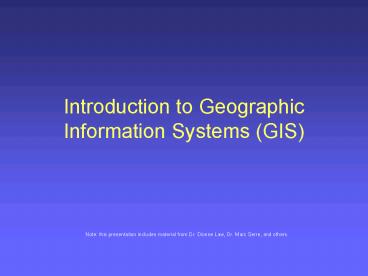Introduction to Geographic Information Systems GIS - PowerPoint PPT Presentation
1 / 25
Title:
Introduction to Geographic Information Systems GIS
Description:
Spatial data are referenced to locations on the earth's surface using coordinate ... Monitoring Station Data was gathered for 3 Watershed Management Areas (WMA) ... – PowerPoint PPT presentation
Number of Views:62
Avg rating:3.0/5.0
Title: Introduction to Geographic Information Systems GIS
1
Introduction to Geographic Information Systems
(GIS)
Note this presentation includes material from
Dr. Dionne Law, Dr. Marc Serre, and others.
2
Organization of presentation
- Basics of GIS
- GIS data at the New Jersey Department of
Environmental Protection
3
Basics of GIS
4
Geographic Information Systems (GIS)
- GIS facilitates visualization and analysis of
spatial data - Spatial data are stored in map layers
5
Coordinate Systems
- Spatial data are referenced to locations on the
earths surface using coordinate systems - Ensure all map layers share a common coordinate
system - Recognized global coordinate systems consist of
- A Spheriod a mathematical description of the
earths shape - A Map Projection a mathematical conversion from
spherical to planar coordinates
6
Map Projection
7
Map Projection
8
Scale
- Tells how map distance relates to real world
distance - Map Scale ratio of map distance to actual
ground distance - 110,000 (1 map cm 10,000 real cm)
- Small scale (1100) vs. large scale (110)
- Scale Bar graphic display of map scale
9
Resolution
- The accuracy with which a given map scale can
depict the location and shape of map features - Larger the map scale, the higher the resolution
- As map scale decreases, resolution diminishes and
feature boundaries are smoothed, simplified, or
not shown at all. - Rule of thumb error 2 of map scale
- Resolution plays a large role in GIS, especially
in raster-based modeling
10
Raster-based GIS
- Data stored in a regularized grid of cells
covering an area - Grid cells called picture elements or pixels
- Nodes, Arcs, Areas
11
Vector-based GIS
- Image and data stored separately
- Data attribute table
- Image points, lines, polygons
12
Summary
- GIS facilitates visualization and analysis of
spatial data - Spatial data are stored in map layers
- Most GIS programs are raster- or vector- based
- Raster - data and image stored together in
regularized grid made of pixels - Vector - data and image stored separately
points, lines and polygons
13
GIS data at the New Jersey Department of
Environmental Protection
14
New Jersey Department of Environmental Protection
- NJDEP
- http//www.nj.gov/dep/
- NJDEP - GIS
- http//www.nj.gov/dep/gis/
- NJDEP - Water Monitoring Standards
- http//www.state.nj.us/dep/wmm/
- NJDEP - Water Monitoring Standards Bureau of
freshwater biological monitoring - http//www.state.nj.us/dep/wmm/bfbm/
15
NJDEP - GIS
- The NJDEP GIS Department (http//www.nj.gov/dep/
gis/) - provides GIS files for state administrative
areas, hydrology, geology, land use, etc., such
as - Counties
- Digital Elevation Grid
- Hydrography
- Watersheds
- Water Quality Monitoring Stations
16
NJDEP - Water Monitoring Standards
- The NJDEP Office of Water Monitoring Standards
- (http//www.state.nj.us/dep/wmm/)
- oversees the Bureau of Fresh Water and Biological
Monitoring . - This bureau is in charge of monitoring the
ambient conditions of the state's fresh and
ground water resources. This monitoring includes
- regular sampling through a statewide network
consisting of 115 surface water monitoring
stations, - 820 benthic macroinvertebrate biological stream
monitoring stations, - 100 fish assemblage biological stream monitoring
stations, and - 150 ground water stations.
17
The Raritan Basin in New Jersey
54 Monitoring Stations Across 3 Watershed
Management Areas
18
(No Transcript)
19
(No Transcript)
20
(No Transcript)
21
Water quality data for the Raritan river basin
- Monitoring Station Data was gathered for 3
Watershed Management Areas (WMA) - N/S Branch Raritan (8)
- Lower Raritan (9)
- Millstone (10)
- Dataset was obtained from two sources
- NJ DEP/USGS Water Quality Network1
- EPA STORET Database2
- Dataset contains 6 water quality parameters
- Discharge, Dissolved Oxygen, Ammonia,
NitrateNitrite, Phosphate, Temperature - Additional Parameters can be added as needed
- Measurements were taken approximately 4
times/year from 1990-2002 - Values were log-transformed depending on
distribution
1http//waterdata.usgs.gov/nj/nwis/qw
2http//www.epa.gov/STORET
22
Phosphate data (mg/L) over the Raritan
The movie of the data illustrate its space/time
variability
23
Challenges
- Sparse network of monitoring sites
- Monitoring data may have varying measurement
errors - High variability of the data over space and time
- The relevant spatial distance metric is a
combination across land and along river
metric - Limited resources prevents use of deterministic
water quality models, but a stochastic version
may provide useful knowledge
24
Conclusion
- In the State of New Jersey, GIS provides a set of
basic functions allowing to query and extract
monitoring data with health concerns. The arcGIS
software will provide the necessary basic
functions of GIS. - The monitoring data varies over space and time,
therefore we need advanced functions of Temporal
GIS to map their distribution at unsampled
locations. The BMElib software of space/time
Geostatistics will provide the necessary advanced
functions of Temporal GIS
25
ESRI arcGIS at UNC
- UNC GIS software includes ESRI arcGIS version
9.0, 9.1, 9.2 - Technical Support http//www.unc.edu/atn/gis
- research_at_unc.edu (919) 962-HELP
- Data Sources http//gis.unc.edu/
- Amanda C. Henley, GIS Librarian
amanda.henley_at_unc.edu (919) 962-1151






























